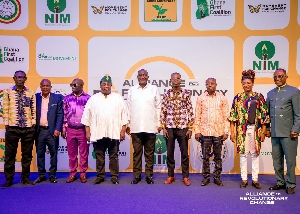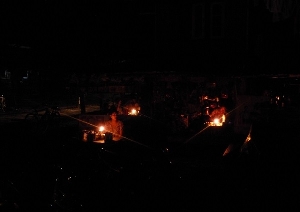 Galamsey operators at work removing the top soil of the arable land
Galamsey operators at work removing the top soil of the arable land
Though mining is a very profitable business that creates employment opportunities for several individuals and benefits everyone in the country including the government that is why the legal mining industries are widely supported by everyone. The government, individuals and the law does not support what is refers as illegal mining called Galamsey in Ghana due to several negative effects on the environment and water in the country.
Due to it illegality the Media Coalition against illegal mining comprising major media organizations in the country have launched to wage a crusade against the menace including the Minister of Lands and Natural Resources, Mr John Peter Amewu, who has given a three-week ultimatum to all illegal miners to stop their activities or be prepared to face the full rigors of the law.
We often hear in news the death of some illegal miners caused by a collapse cave or them being buried alive in collapse pits which always brought despondency to every citizen who get access to consume that news due to the fact we all live in one society which is also an effect of this canker due to the proximity of the news. Lands and water of these communities are deteriorating day-in day-out by these miners and one cannot underestimate the dangers of chemicals used in mining in these communities as they pollute air and water such as change water colour, taste and give off bad smell making lands also infertile to support plant growth.
The pollution is not only dangerous to human life but the other living organisms which support human existence, thus, in turn destroying the entire ecosystem which does not now affect directly like those who die in the pits only but rather has an impact on every living organism including us.
In recent year, a similar catastrophe hit the people of Dunkwa On-Offin in the Central Region where several people were buried in galamsey pit when it caved on them near the Offin River. It was reported that over 100 perished in that singular tragedy. Reports indicated that about 136 galamsey operators were working in the pit when that incident occurred on Sunday June 27, 2010. About 13 bodies were recovered by the rescue operation that was hampered by pouring water from the Offin River. In recent times, it has been a tragedy upon tragedy as another calamity was recorded at Attaso, near Kotokuom in the Ashanti Region, with at least 12 galamsey operators trapped in a collapsed pit. Nine bodies were retrieved from the pit (posted on Daily Guide website on November 26, 2011).
A recent study conducted by the UN Industrial Organization found that the majority of villagers sampled, including non-miners, carried unsafe levels of mercury in their bodies. The concentration found in fish was three times higher than levels deemed safe by the U.S. Environmental Protection Agency (EPA).
Reports also stated that, “in a week at least one person dies” as a direct result of the various pollution-related activities by illegal miners (CLP, Galamsey: Will Work for Gold, January 18, 2010). That is why it very imperative to stamp out this Galamsey canker now to withhold our nation from depletion of our ecosystem.
EFFECTS OF GALAMSEY ON LANDS
Galamsey has numerous negative effects on wildlife which is a broad term that refers to all plants and any animals (or other organisms) that are not domesticated. Galamsey mining really affects the environment and associated biota through the removal of vegetation and topsoil; it is also an agent of the displacement of creatures, the cause of hanger, the release of pollutants, and the generation of destructions.
The impacts start primarily from disturbing, removing, and redistributing the land surface making it very cumbersome for the land to basically perform it function to mind kind.
Some of these negative impacts are short-term and confined to the mine site; others may have far-reaching, long-term effects. This reminds me a study conducted by Serfor-Armah (2006) to assess the impact of small-scale mining on land in the Western part of Ghana revealed that mining removes vegetation and topsoil, and often results in inevitable loss of farmland permanently. They further reported that surface mining alone accounted for about 58% of the region’s deforestation, 45% loss of farmland (within mining concessions) and pervasive spillover effects often resulting from expansion of mining activities into reserved forests.
However, another effect of the Galamsey which is now has been the national canker on land, has been that of what is refers as habitat fragmentation that occurs when large areas of land are broken up into smaller and smaller patches, making dispersal by native species from one patch to another difficult or impossible, and cutting off migratory routes. Isolation may lead to local decline of species, or genetic effects such as inbreeding. Species that require large patches of forest simply also disappear and at the end affect the higher production of Agriculture in Ghana.
According to Mensah AK (2015) another area where mining has a devastating effect on the environment in Ghana is the soil. Many research findings indicated that soils are adversely affected by surface Galamsey. During the mineral’s extraction, important soil organisms have been destroyed, stable soil aggregates disrupted, and eventually depriving the soil of organic matter. These soils, or newly created substrates/growth are often inhospitable to vegetation due to combination of physical, chemical and microbiological factors.
In a related development, Hilson stated that nearly all mine substrates have very low levels of macro-nutrients (especially nitrogen (N), phosphorus (P) and potassium (K). Hilson G (2001) he also argued that regardless of the overburden type used, plant available N and P tend to be low on mined soils, which may limit tree growth and also added that the consequences of physical disturbance to the topsoil during stripping, stockpiling and reinstatement, cause unusually large nitrogen transformations and movements with eventually substantial loss of soil fertility and productivity.
Low pH is a particularly intransigent problem in wastes that contain iron pyrites, which, on weathering, will generate sulphuric acid and (if there is no acidic neutralizing capacity in the waste) induce pH values of 2.0. Other problems include toxicity, especially of aluminum, zinc and other metals in acidic wastes, and these can significantly affect plant growth.
EFFECTS OF GALAMSEY ON WATER
W. H. Auden said “thousands have lived without love, not one without water” it mean water is indispensable to human existence and without water, we cannot live that is why it is imperative for us to protect our water bodies so as our generation should even benefit.
But given a chance for a Galamsey to dominate in this country, will not help Ghana to achieve that goal. Moreover, the most significant impact of a mining especially Galamsey project is its effects on water quality and availability of water resources within the project area. Key questions are whether surface and groundwater supplies will remain fit for human consumption, and whether the quality of surface waters in the project area will remain adequate to support native aquatic life and terrestrial wildlife.
Results from the field observations in the study area revealed that major rivers in the area such as Ankobra and Asesree, which used to serve as the main sources of water for domestic purpose in the surrounding townships, had been heavily polluted by mining activities especially those of illegal small-scale mining Galamsey. Mining, especially surface mining results in adverse environmental impacts on water bodies (rivers and streams) in Ghana through a release of effluents such as mercury, arsenic and solid suspensions.
Likewise, according to Okoh G, Hilson G (2011) discovered that between 1994 and 2001, five major cyanide spillages and leakages occurred resulting in contaminating some major rivers in Ghana. He further indicated that cyanide spills and leakages by this Galamsey resulted in polluting the Anikoko, Angonabe, Bodwire and Assaman rivers, all in the western region of Ghana. This led to a significant loss of aquatic organisms, displacement of people, and a depletion of livelihood and drinking water for some communities within that area.
Furthermore, Smedley PL, Edmunds WM, Pelig-Ba KB (1996) also had an Interviews with some residents in Prestea during the field survey which revealed that they are spending huge sums of money to access and treat groundwater for their domestic use such as drinking, cooking, washing and bathing. Consequently, the government had embarked on digging boreholes for some communities to access water for their domestic use. Residents in Prestea have therefore resorted to use of groundwater. What I know about this research is that during that time, one respondent in an interview revealed that they drill as deep as 80m underground just to reach water that is free from contaminations. He further added that they incur a cost of as much as 12,000 Ghana Cedis at that time (equivalent of 3,500 USD) in drilling, laying pipes to tap the groundwater as well as putting up the POLYTANK for water storage and supply.
This is due to the fact that most of the rivers (surface water sources) have been heavily polluted and their water rendered unsafe for domestic use due to this Galamsey activities in the area.
Here the question is if Galamsey continues as it is today can Government have such huge money to provide numerous wells from the all Communities around these mining areas?
Similarly, Smedley PL, Edmunds WM, Pelig-Ba KB (1996) again find in their study that high levels of arsenic contamination in drinking water from streams, shallow wells and boreholes in Obuasi, in the Ashanti region of Ghana, ranging from 2 to 175µgl-1. This was attributed to two factors: mine pollution and natural oxidation of sulphide minerals predominantly arsenopyrite (FeS2).
Galamsey mining activities can suddenly affect quality of life and the physical, mental, and social well-being of local communities. Improvised mining towns and camps often threaten food and water availability and safety, increasing the risk of malnourishment. Indirect effects of mining on public health can include increased incidence of tuberculosis, asthma, chronic bronchitis, and gastrointestinal diseases.
A typical example is the situation of East Akyem District where miners polluted the Birim, Densu and Ayensu Rivers which served as their main raw sources of water for communities around where the citizen compelled to opt to use the same polluted rivers without any panic. The reason being that, there was scarcity of raw filtered water at that particular area in the country and therefore, they drink, cook, bath and perform all tasks with these available polluted water in spite of the risk of even contracting diseases such as cholera, dysentery, fever, amongst others.
According to scientists at the University of Manchester (UK) and the University of Colorado(U.S.): “Impacts on water quality and quantity are among the most contentious aspects of mining projects like our local Galamsey and therefore, Companies insist that the use of modern technologies will ensure environmentally friendly mining practices. However, evidence of the negative environmental impacts of Galamsey activity causes local and downstream populations to worry that these mining activities will adversely affect the water supply in the communities around mining areas like Obuasi, Abirim, prestea among others.
There are major stakes in these conflicts, affecting everything from local livelihood sustainability to the solvency of national governments. Fears for water quantity and quality have triggered numerous and sometimes violent conflicts between miners and communities in the country as well as even our neighboring countries. And that is what is trending at the moment in Ghana therefore, we should all come together to stop this canker for safety of purified water and protect our able arable lands that can boost our Agricultural production which is also the bedrock of our economy.
Low pH is a particularly intransigent problem in wastes that contain iron pyrites, which, on weathering, will generate sulpharic acid and (if there is no acidic neutralizing capacity in the waste) induce pH values of 2.0. Other problems include toxicity, especially of aluminum, zinc and other metals in acidic wastes, and these can significantly affect plant growth.
RECOMMENDATIONS
I will therefore recommend that the government should formulate a policy that may include the following:
1.Encouraging and assisting the Galamsey people to come together and acquire legal permits, or the government forming a state own mining companies which can takes over the mining site of galamsey miners or a joint stock mining companies comprising the government and some interested sponsors in order to operate it professionally with the necessary machines and proper management of chemicals, water, forest and land in scientific way in which it will rather boost crop production and afforestation of the affected area and again, see to it that our water bodies are not affected by this operation in order to also create employment for individuals in that sector.
2. In addition to either of the above; the government should persecuting anyone who will fails to comply with the mining laws and directive in the country should therefore, prepared to face the full rigors of the law.
3. Also, educating them on the effects of their operation and assure them that there are safe methods of mining, discouraging especially the youth and providing financial support for the youth to further their education whilst expanding creation of jobs for the youth.
4. Government should create and promote jobs and/or business opportunities as promised to serve as alternative to Galamsey so that they can easily quit Galamsey. In addition to this, educating and encouraging them to use the money that they have already acquired from Galamsey to invest in other business so that they can cater for their families after quieting Galamsey.
5. Parents should also take up a proactive role in educating and advising their Children about the negative effect of Galamsey on it short and long run due to the disasters involved in these activities and the depletion of the ecosystem that can affect everybody.
6. Mining Companies should pay higher percentage as royalties and provide business opportunities in place of farming and also engaging in practice that can still make lands good and less risky for farming in order not to lose our arable farmlands and also expand their tentacles in order to absolved more people with such experience to work with them to reduce unemployment.
Therefore, this sector should not remain unchecked because that will cost Ghana more than half of our revenue generation for treatment of water, planting trees, treating diseases and in terms of resources, we will lose some plant and animal species that can never be recovered.
We should all think of better ways to help solve this menace; otherwise we will wake up one day to find out that we do not have any potable water because all the water bodies, as well as our ground water, have been polluted and our farmlands also cannot perform it duties for mankind through the unbridled activities of these illegal miners.
We should stamp out this menace which is now the national canker, an enemy and abstain from rhetoric to work hard to stamp Galamsey out and with courage, perseverance, one goal, determination, unity we can all amicably find a solution to the problem for our development. God bless Ghana.
By Abraham Frank Eshun
Eshunfac2009@yahoo.com
Eshunfac2009@gmail.com
Public Relations Officer
Cape Coast Metropolitan Assembly
Cape Coast
- Mining pit collapse kills two illegal miners, others rescued
- Illegal mining threatening Ghana's $230 million Cocoa Rehabilitation Project
- What former EPA boss said about Ghana's galamsey-induced cocoa beans
- Illegal miner falls and drowns in abandoned mining pit
- Watch as youth of Sefwi Akontombra seize volumes of fuel allegedly heading to a galamsey site
- Read all related articles












